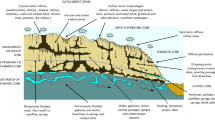Abstract
Echelons provide an objective approach to prospecting for areas of potential concern in synoptic regional monitoring of a surface variable. Echelons can be regarded informally as stacked hill forms. The strategy is to identify regions of the surface which are elevated relative to surroundings (Relative ELEVATIONS or RELEVATIONS). These are areas which would continue to expand as islands with receding (virtual) floodwaters. Levels where islands would merge are critical elevations which delimit echelons in the vertical dimension. Families of echelons consist of surface sectors constituting separate islands for deeper waters that merge as water level declines. Pits which would hold water are disregarded in such a progression, but a complementary analysis of pits is obtained using the surface as a virtual mould to cast a counter-surface (bathymetric analysis). An echelon tree is a family tree of echelons with peaks as terminals and the lowest level as root. An echelon tree thus provides a dendrogram representation of surface topology which enables graph theoretic analysis and comparison of surface structures. Echelon top view maps show echelon cover sectors on the base plane. An echelon table summarizes characteristics of echelons as instances or cases of hill form surface structure. Determination of echelons requires only ordinal strength for the surface variable, and is thus appropriate for environmental indices as well as measurements. Since echelons are inherent in a surface rather than perceptual, they provide a basis for computer-intelligent understanding of surfaces. Echelons are given for broad-scale mammalian species richness in Pennsylvania.
Similar content being viewed by others
References
Antenucci, J., Brown, K., Croswell, P. Kevany, M. and Archer, H. (1991) Geographic information systems: a guide to the technology. New York: VanNostrand Reinhold.
Carr, D. (1991) Looking at large data sets using binned data plots. pp. 7–39 in: A. Buja and P. Tukey (eds) Computing and Graphics in Statistics. New York: Springer-Verl
Carr, D., Littlefield, R., Nicholson W. and Littlefield, J. (1987) Scatterplot matrix techniques for large N. Journal of the American Statistical Association 82(398), 424–36.
ESRI (1992) ARC/INFO user's guide: Surface modelling with TIN; surface analysis and display. Environmental Systems Research Institute, Inc., Redlands, CA.
Hall, P., Qian, W. and Titterington, D. (1992) Ridge finding from noisy data. Journal Computational and Graphical Statistics 1(3), 197–211.
Isaaks, E. and Srivastava, R.M. (1989) An introduction to applied geostatistics. New York: Oxford University Press.
Joly, K. (1996) Mammalian biodiversity in Pennsylvania at the USEPA 635 square kilometer hexagonal scale. Master of Science thesis, The Pennsylvania State University, The Graduate School, Intercollege Graduate Degree Program in Ecology, University Park, PA.
Lillesand, T. and Kiefer, R. (1994) Remote sensing and image interpretation, 3rd ed. New York: Wiley.
Myers, W. (1994) Environmental remote sensing and geographic information systems-based modeling. Ch. 18 in: G. P. Patil and C. R. Rao (eds). Handbook of Statistics 12; Environmental Statistics. New York: North-Holland Elsevi
Myers, W. and Patil, G.P. (1996) Spatial clustering of polygonal maps having ordinal attributes for landscape analysis. Computing Science and Statistics 27, 147–54.
Myers, W., Patil, G.P. and Taillie, C. (1995) Comparative paradigms for biodiversity assessment. pp. 67–85 in: T.J.B. Boyle and B. Boontawee (eds). Measuring and Monitoring Biodiveristy in Tropical and Temperate Forests. Proceedings of IUFRO Symposium held at Chiang Mai, Thailand, Aug. 27-Sept. 2,1994. CIFOR Center for International Forestry Research, Bogor, Indones
Plant, R. and Stone, N. (1991) Knowledge-based systems in agriculture. New York: McGraw-Hill.
Scott, J.M., Davis, F., Csuti, B., Noss, R., Butterfield, B., Groves, C., Anderson, H., Caicco, S., D'Erchia, F., Edwards, T.C., Jr., Ulliman, J. and Wright, R.G. (1993) Gap Analysis: a geographic approach to protection of biological diversity. Wildlife Monographs, No. 123.
Strahler, A. (1964) Quantitative geomorphology of drainage basins and channel networks. Sections 4-11 in: V. Chow (ed.) Handbook of Applied Hydrology. New York: McGraw-Hill.
Tukey, J. (1982) Another look at the future. Computer Science and Statistics: Proceedings of the 14th Symposium on the Interface. New York: Springer-Verlag.
Wegman, E., Carr, D. and Luo, Q. (1993) Visualizing multivariate data. pp. 423–66 in: C.R. Rao (ed.) Multivariate Analysis: Future Directions. New York: North-Holland Elsevier.
White, D., Kimerling, A. and Overton, W.S. (1992) Cartographic and geometric components of a global sampling design for environmental monitoring. Cartography and Geographic Information Systems, 19(1), 5–22.
Author information
Authors and Affiliations
Rights and permissions
About this article
Cite this article
Myers, W., Patil, G.P. & Joly, K. Echelon approach to areas of concern in synoptic regional monitoring. Environmental and Ecological Statistics 4, 131–152 (1997). https://doi.org/10.1023/A:1018518327329
Issue Date:
DOI: https://doi.org/10.1023/A:1018518327329




